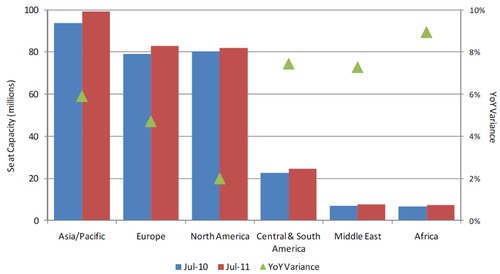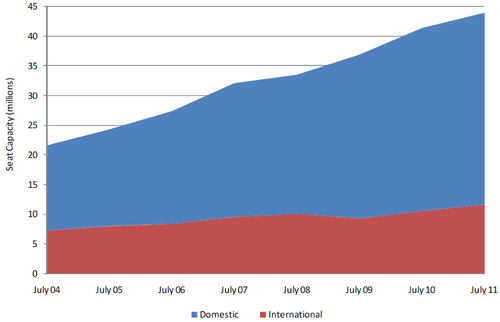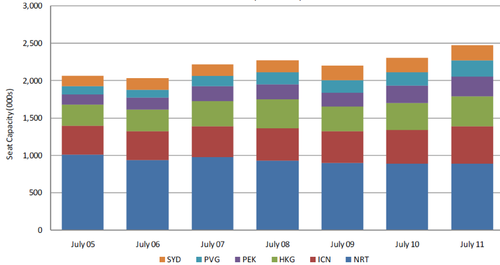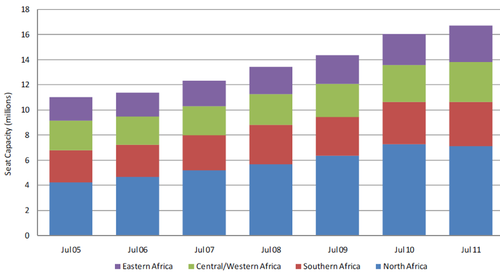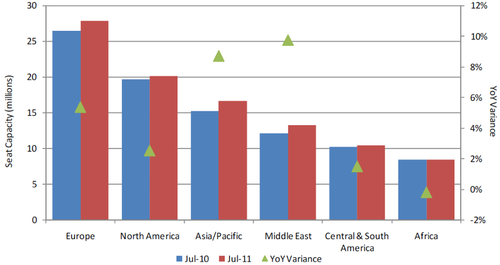LCCs bolster global airline growth; Asia Pacific hosts seven of the world's largest 20 airports
Growth in scheduled airline operations showed continued signs of moderating in Jul-2011, according to the latest statistics from OAG for Jul-2011. LCC growth, however, continued to rise, with LCCs now having a worldwide scheduled capacity share of 25%, with an additional 7.5 million seats in the gloabl LCC network compared with Jul-2010.
In Jul-2011, global seat capacity growth stood at 5% (to 351.4 million seats), following growth of 5% in Jun-2011 and 6% in May-2011. Increases in aircraft size continue to be a key driver of seat capacity growth. Average seats per frequency increased from 125 seats in Jul-2010 to 127 in Jul-2011. The total number of scheduled flights operating in Jul-2011 increased at a slower pace, by 3% year-on-year to 2.8 million.
Middle East continues to be fastest growing region followed by Africa
In capacity terms, the Middle East continues to be the fastest growing region, with a 10% year-on-year increase in seats in Jul-2011. This is closely followed by within Africa with a growth of 8.9%, and then by to/from Asia, which saw a monthly year-on-year increase of 8.7%.
When looking at growth in frequencies, to/from Asia leads the pack. The region recorded an 11% year-on-year growth in frequencies in the month. Not far behind is the to/from Middle East market, which recorded a 9% year-on-year increase.
Asia Pacific remains largest region by seat volumes
The intra-Asia Pacific region maintained its leading position in relation to total seat volumes in Jul-2011. Now just 1 million seats short of the 100 million mark, frequencies and seats within the region both grew by 6% year-on-year for Jul-2011, adding 5.5 million additional seats and 39437 more services. Meanwhile, frequencies and seat capacity to/from Asia Pacific has increased by 11% and 9% respectively.
Intra-regional seat capacity within region: Jul-2011
Domestic capacity in China grew by 5% year-on-year and maintains its status as the second largest domestic market in the world, some way ahead of Brazil in third. China's international capacity has made an even sharper increase, with an additional 1.1 million international seats being added over the past 12 months.
China's domestic and internationals seat capacity: Jul-2004 to Jul-2011
Intra-Europe and intra-North America regions a similar size
The intra-Europe and intra-North America regions are only separated by around 1 million seats in Jul-2011, with 82.8 million and 81.8 millions seats respectively. However, at 5%, intra-Europe's growth rate for Jul-2011 is 3 points ahead that of intra-North America.
In Jul-2011, carriers in Europe will operate 640,290 flights and offer 82.8 million seats as Europe enters the busy summer holiday period. Scheduled capacity to/from Europe also grew in Jul-2011 with an increase of 5% in the number of flights and offered seats. The majority of the expansion is being driven by LCCs, with a 7% increase in capacity, although traditional carriers have also seen a rise in seat capacity, providing 5% more seats.
Growth between western Europe and the Middle East continues apace, with only London out of the major cities reporting a decline in frequencies (-3%) and seats (-1%). Milan (25%), Rome (10%), Amsterdam (19%) and Madrid (40%) all made large double-digit capacity growth between the two regions. With continued aircraft deliveries scheduled for the main Gulf carriers it can be assumed that growth between Europe as a whole and the Middle East will continue for the foreseeable future.
Within North America there is an increase in frequencies of 0.1%, and an increase in seat capacity of 2% in Jul-2011. Frequency of service to/from North America is increasing 1% in the month, with seat capacity growth of 3%. In all there will be 20.1 million seats available during Jul-2011.
Growth between North America and major Asia hubs
Seat capacity in Jul-2011 between North America and major hubs in Asia has now reached levels in advance of those seen prior to the Global Financial Crisis. Overall, seat capacity between the two regions grew by 8% with Shanghai being the top performer out of the major hubs, growing by 22% in Jul-2011.
Seat Capacity between major North America and major Asian Hubs: Jul-2005 to Jul-2011
North continues to hold majority of African capacity share
Of the main regions, both to/from Africa and to/from Central and South America recorded a year-on-year decline in frequencies. Both are down 1% for Jul-2011. However, to/from Central and South America saw a year-on-year increase in available seat capacity of 1.5%. To/from Africa seat capacity declined fractionally by 0.2%.
However, total African seat availability in Jul-2011 increased by 4% year-on-year. North Africa continues hold the majority of the market share of capacity. However, this was the first time that it has seen its market share for Jul-2011 decline in recent years. This can be attributed to unrest in this region of Africa. Eastern and Central/Western Africa both saw slight increases in their market share, climbing to 17% and 19% respectively.
Available Seat Capacity to/from and within Africa: Jul-2005 to Jul-2011
Africa to Paris and Africa to London continue to be the Africa's most significant intercontinental markets. However, both saw a year-on-year decline in seat availability for Jul-2011, with Paris declining 2% to 694,735, and London falling by 4% to 601,847. Route developments during Jul-2011 include; Senegal Airlines launching four new destinations from Dakar. Cotonou, Douala, Libreville will operate via Abidjan, and a direct service to Praia. After a 21-year absence Egyptair will be resuming services to Iraq with four times weekly service from Cairo to Baghdad and three times weekly Cairo-Erbil service.
International seat capacity to/from regions: Jul-2011
LCCs have a quarter of world capacity share
In Jul-2011, LCCs have a worldwide scheduled capacity share of 25%, with an additional 7.5 million seatscompared to Jul-2010. This equates to a year-on-year increase of 9%, which is on par with the growth seen in the 1H2011.
Europe still dominates the LCC market with 31.5 million intra-European seats scheduled in Jul-2011, marking an increase of 2.3 million seats. LCCs now represent nearly 30% of all traffic within and to/from Europe, with LCC seat capacity increasing 7% in the month.
Seat Capacity to/from and within Europe by carrier type: Jul-2002 to Jul-2011
Similar volume growth was experienced by the intra-Asia market. LCC presence within the Asia/Pacific region grew rapidly, increasing capacity by 2.25 million available seats to 18.8 million, for growth of 14%. Low-cost seats to/from the Asia Pacific region witnessed an increase of 21% year-on-year.
Meanwhile, the fastest growing market continues to be intra-Africa which grew 24% for Jul-2011, albeit from a significantly lower base. Frequencies within this market also grew by 35%.
Intra-regional LCC seat capacity within region: Jul-2011
As has been the case in previous months, despite the marginal growth in capacity in the Central and South American markets, LCCs continue to grow rapidly. Frequencies to/from the region grew by 20%, while intra-regional frequencies grew by 12%. LCC now make up 32% of total intra-Central and South America seat capacity, and 14% of to/from Central and South America seat capacity. LCC capacity to/from Europe (-12%) and to/from Africa (-5%) both saw a year-on-year decline in Jul-2011, as a result of frequency cutbacks due to unrest in North Africa and the Middle East.
International LCC seat capacity to/from region: Jul-2011
LCC traffic to/from and within North America both experienced increases with available seats within the region increasing by 6% and to/from North America increasing by 16%, adding over 200,000 additional seats.
Atlanta remains largest airport; Asia Pacific has seven in top 20
The world's largest airport, Atlanta, saw a 3% decline in frequencies in Jul-2011. However, this decline was nullified by a 3% increase in actual seat capacity. This is a sign that carriers are opting for larger aircraft, with the average number of seats per aircraft rising from 115 to 122. Despite a 0.3% decline in seat capacity, London Heathrow maintain its position at number three, but Beijing continues to consolidate its number two spot with an increase in available seats of 2% year-on-year.
Asia Pacific has seven of the top 20 airports by capacity in Jul-2011, with Beijing, Tokyo Haneda, Hong Kong, Singapore, Bangkok Suvarnabhumi, Jakarta Soekarno Hatta and Shanghai Pudong representing more than 43.2 million seats and 206,043 flights for the month.
Delhi continues to be the fastest growing hub in the Asia Pacific with frequencies up 20% and available seats increasing by 22%. However, one spot below on the global table was Hanoi. Hanoi has seen frequencies increase by 28% and seat capacity up 21% in Jul-2011. Hanoi now has a total of 1.33 million seats per month in Jul-2011, up 232,660 on Jul-2010. A significant proportion of that capacity has come from Qatar Airways' four times weekly Doha to Hanoi service which operates via Bangkok.
OAG also reported some positive news for Tokyo Haneda. Despite seeing a slight drop in overall seat capacity for Jul-2011 compared with Jul-2010, there was a 14% increase in frequencies indicating that airlines are looking to improve schedules, but with smaller aircraft compared with the pre-11-Mar-2011 earthquake period.
Madrid was the only airport within the top 20 that reported a decline in passenger numbers, despite the pressures of a weak economy and austerity measures. Madrid reported a decline in frequencies of 2%, and also a decline in seat capacity of 1.3%. A similar picture is painted in Greece, where the economy has just been bailed out for a second time by the European Union. Athens recorded an 8% decline in frequencies and a 1.3% reduction in seat capacity.
In terms of absolute volume, Istanbul Ataturk experienced the largest growth with a rise of close to 1 million seats, a 27% year-on-year increase. Of the top 10 airports, both Los Angeles and Hong Kong reported increases in seat volume of around half a million compared with Jul-2010 levels.
